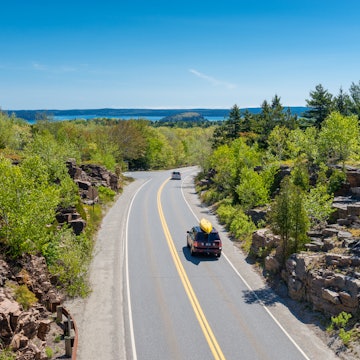

Toronto is the perfect cosmopolitan stop on a cross-country trip. d3sign / Getty Images
Canada is big and beautiful, but climate, distance and the high cost of domestic travel make it a hard country to get to know. Having the freedom to throw your stuff in the trunk and set off as you please makes driving a tempting way to explore this spectacular country.
The Trans-Canada Highway is one of the world's longest roads, spanning 7821km (4859 miles) from St John’s, Newfoundland, to Victoria, British Columbia. The route spans all ten provinces and flirts with the Atlantic and Pacific oceans at its limits. It crosses four islands, passes through tundra, boreal forests, national parks and prairies, glaciers, a few thousand lakes and twists beneath the shadows of vast peaks. But you need more than wanderlust to hit the road; you need a car, a plan and what's that about winter tires? Never fear, this practical guide will see you zooming across Canada in no time.
Editor's note: please check local travel restrictions before planning any trip and always follow government health advice.
How to rent a car in Canada
This is the easiest way to get on the road, but one-way penalties can exceed hundreds of dollars and rentals between some locations are prohibited. Experiment with your route – returning your vehicle where you collected it will save you money. Most rates don’t include comprehensive insurance, which the agency will coax you to purchase for an additional daily fee. Many credit cards and travel insurance policies do cover rental car insurance.
Clarifying the fine print with all parties could save money and bring peace of mind. Remember to confirm the number of miles included, especially with RV rentals. If you're flexible, you could get lucky with a relocation, where you pay a drastically reduced rate to deliver a vehicle between depots, sometimes with free fuel. Relocation contracts for private vehicles can also be found.
More information: renting and relocation
www.kayak.com/cars – compares rates
www.torontodriveaway.com – private vehicle relocations from east to west
www.canadream.com – RV relocations (under the Hot Deals tab)
Buying a used car in Canada
Long-term visitors on a working holiday might want to investigate buying (and reselling) a used vehicle. Mandatory insurance should be your first concern – it’s expensive. In Ontario, ownership is not transferable until the purchaser's insurance has been issued. In British Columbia, Saskatchewan and Manitoba, car insurance is operated by the government. In all other provinces and territories, you're on your own.
Rates vary by location, driving history, vehicle age and type. You can purchase a vehicle without a Canadian license, but you need to have a fixed address for insurance and registration. Regardless of your driving experience back home, you'll be considered a 'new driver', which will elevate your premium and make you ineligible to insure vehicles 15 years or older. Banks have the best premiums for new drivers – private insurers are reluctant to take on the liability. Be sure to clarify the cancellation penalties if you plan on selling after a few months, as policies are sold on a yearly term.
More information: researching insurance
www.tdinsurance.com – cheapest premiums for new drivers
www.rbcinsurance.com – comparison rates for new drivers

Where to buy your vehicle will be dictated by your circumstances and where you plan to travel. Ontario has a huge market for used cars. It may seem like looking for a limo in a lemon tree, but bargains can be found. The Catch-22 is that Toronto has the highest insurance premiums (provinces to the east have the lowest) and if you buy here, you must insure here.
Tips and tricks for buying a vehicle in Canada
Trusting your seller is important. A good dealership will 'do it all for you', but their prices include commission and vehicles may not be what they seem. Many dealers offer 'as-is' vehicles, which usually do not include safety certification – avoid these tempting 'bargains'. They may appear to be priced well and look great, but without certification, cannot be driven from the lot. It is the buyer's responsibility to tow and certify the vehicle elsewhere, at unknown expense, or have the dealer certify the vehicle for an elevated fee. Such vehicles may also harbour undisclosed mechanical problems. When buying privately, try to get the seller to include the vehicle certification in the price. Find out if the vehicle has a maintenance history with a reliable mechanic.
It is mandatory for dealers (but not private sellers) to disclose if a vehicle has any outstanding liens (unpaid debts) against it. Legally, once such a vehicle is resold, the onus on repaying these debts transfers to you, the buyer. Reputable dealers and trustworthy private sellers should provide a Used Vehicle Information Package (UVIP) outlining the car's ownership, accident and finance history. If they don't, ask for one. You can obtain a UVIP yourself from the Licensing Offices of the Ministry of Transportation for $20.

Searching online for the terms 'one owner' and 'service history' might uncover those harder-to-find, well-loved cars, put up for sale by honest owners. Exercise caution whichever route you take. It is possible to buy a reliable vehicle for around CAD$3000, all in. You should be able to sell it when you’re done and recoup a chunk of your investment.
Post-2000 Toyotas and Hondas are generally fuel efficient, inexpensive to maintain and have good resale potential. Volkswagens and Volvos are noteworthy, but parts are more expensive. Cheap SUVs seem perfect for cross-Canada treks, but may harbor costly problems with the chassis and suspension.
More information: buying a used car
www.ebayclassifieds.com – free classifieds site
www.autotrader.ca – largest paid classifieds site
www.edmunds.com - used and new car reviews
www.gasbuddy.com - lists gas prices and calculates estimated fuel costs
Winter weather driving in Canada

Canada’s roads are salted in the winter – check your prospective vehicle thoroughly for signs of the demon rust. Most older vehicles need their timing-belt replaced every so often – failure to do so can destroy the engine. Confirm with the seller when this was done. Check the brakes and tire tread. Are winter tires included? Do you need them? Are gear changes smooth? When considering price, remember you have to pay tax on the sale, which can be as high as 13%.
Registering your vehicle in Canada
Once you’ve found your chariot, everything you need to know about registering your vehicle in Canada is below:
Alberta – www.servicealberta.gov.ab.ca
British Columbia – www.icbc.com
Manitoba – www.mpi.mb.ca
New Brunswick – www.gnb.ca
Newfoundland & Labrador – www.gs.gov.nl.ca
Nova Scotia – www.gov.ns.ca
Ontario – www.mto.gov.on.ca
Prince Edward Island – www.gov.pe.ca
Québec – www.saaq.gouv.qc.ca
Saskatchewan – www.sgi.sk.ca
Finally, save yourself some heartache by registering for the Canadian Automobile Association’s roadside assistance.
If you're keen to get intimate with Canada from coast to coast, a little research and proper planning will reveal the best means of getting around. Make comparisons, do the math and be sure to explore your options before setting out – it doesn't need to cost the earth.
Planning your dream route
So you've got wheels, now what? Be inspired by one of our favorite journeys around Canada:
This article was first written in March 2013 and last updated September 2020.
















